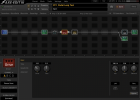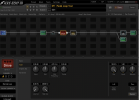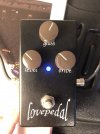Today I recalled that some time ago I made a test inspired by this old Cliff interview:
https://guitarmessenger.com/cliff-chase-interview-fractal-audio/
This bit in particular:
"
IC: Did you actually run out of resources on the Ultra? Were there things that you were trying to run on it that you couldn’t?
CC: Yeah, in terms of processing power it just doesn’t have enough power to run the new algorithms. It’s this thing we called G2 Modeling. It’s basically like a digital algorithm that simulates the way a tube triode works. Nowadays, when most people do modeling, they use what are called wave shapers, which is basically just a nonlinearity in math. So they’ll say you can either use polynomials or piecewise polynomials. I believe a lot
of the earlier company that begins with an L used a thing called a piecewise polynomial, which basically says if your input signal is over a certain value, then this is your function. If it’s between this value and another value it’s this function, and you splice all those polynomials together.
There are other approaches where you just use a polynomial or trigonometric functions and things like that. The problem with all those approaches is they are static – they’re a static transfer function. So whenever the input is here you know the output is… I mean, you can plot it on a piece of paper. You always know. Real tubes, on the other hand, have memory. They don’t have memory themselves, but they have memory due to their parasitic capacitance. Due to the actual terminal impedances, most designers will put a cathode cap on there, and a lot of times there will be a capacitor on the plate as well and possibly on the grid.
So those capacitors remember the charge that was on them, because charge can’t bleed off instantaneously. Or at least it can’t without burning up the traces on the board. So G2 Modeling is actually like a wave shaper, but it has memory, and so the transfer function changes over time based on the memory of the function. And it’s also based on the feedback and the frequency and everything else, so just like a real tube that transfers function changes with amplitude and time.
That, however, is a very CPU intensive process. It requires a lot of steps to simulate that. Simulating just one triode is almost as much horsepower as the entire modeling in the old Axe-Fx. When you start stringing together three or four triodes the algorithm is much more CPU intensive. You couldn’t run that on an Ultra and have any horsepower left for anything else, maybe just a basic delay and a reverb and something. Customers wouldn’t be very happy if they had an inventory of fifty effects and they could only use an amp, a cab, and one effect at a time. So the only way around that for the Axe-Fx II, given that we’re kind of at a plateau in DSP processing speeds right now, is to put two of them in there. One of them is dedicated to just the amp modeling and the other one does all the other stuff."
And here's the test I did to hopefully verify what he's explaining about the "memory" of the circuit and the fact that axe fx algorithms don't always produce the same result for the same input signal:
I recorded a short sample by feeding the same signal to two identical amp blocks, each one recorded on a separate channel in the daw, then I inverted the phase on one of them and this is what came out
If you do the same experiment with helix native or some other plugin you get just silence when you invert the phase, that means the output is always the same if the input signal is the same, so they use waveshapers.
So now I repeated the test with the drive block and even in this case the result is just silence, thus I assume the drive block uses waveshapers as well and not the complex algorithms used for the amp block.
I don't know if drives would gain a substantial benefit from those algos, all I know is that drive pedals have a lot in common with tube amps in terms of circuit implementation so maybe they also share most of those weird and interconnected behaviours the amp block simulates.
The CPU usage would probably increase a lot though so maybe Cliff thinks it's not worth it to waste processing power for drives.




